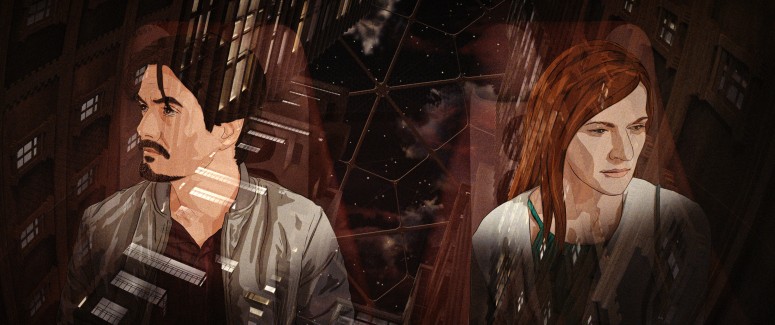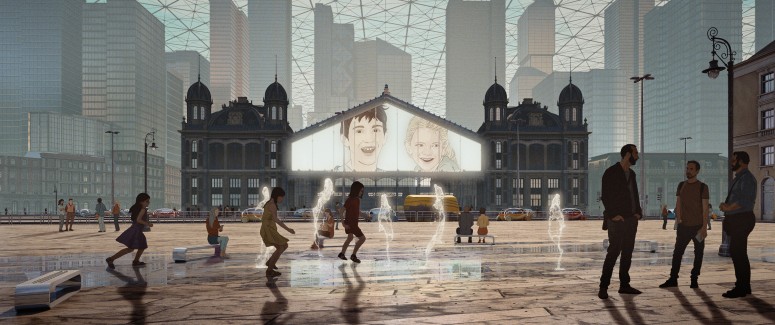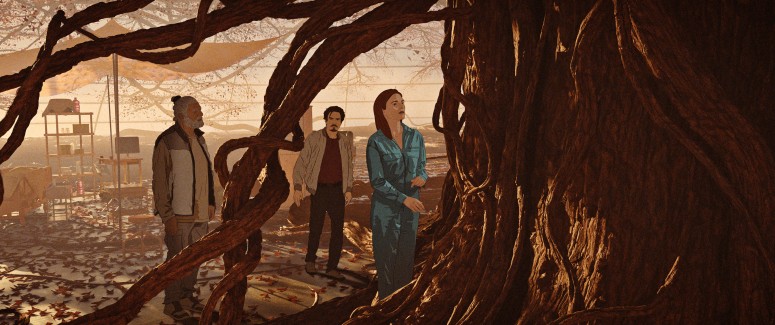White Plastic Sky (Műanyag égbolt) is the first feature by Sarolta Szabó and Tibor Bánóczki. The film is set very far from now in the near future, more precisely, 2123. All animals and plants are gone on Earth, and the remaining humans are living under a plastic dome. The rules are strict, and at the age of 50, they are implanted with a special seed that turns them into a tree which will provide oxygen and food for the community. The young Stefan is seemingly accepting the order of things until his wife Nora decides to sacrifice herself and become a tree before her time. Only then does he decide to break the rules to save her.
Stefan and Nora have lost their son, Tomi The film deals with their grief, as well as the dire circumstance the world is in. What is the actual cause of Stefan’s actions? Does he have the best of mankind in mind, or does he merely want more time with Nora? And if so, is that necessarily something negative? In a time when many allegedly environmental concerns are little more than window dressing, this film approaches human emotions which don’t contradict true emotions for the planet, as well. One of several strong aspects of White Plastic Sky is that it never becomes didactic and always leaves room for the spectator’s interpretation. In that regard, it resembles EO.

The story starts out in Budapest, with some of the city’s famous landmarks like Oktogon and the Western station. Around halfway through, the story takes the couple north to the city of Miskolc, a city that used to be heavily industrialised. It’s a refreshing choice of location since it hasn’t been overused. Of course, there is Who The Hell is Bonnie & Clyde (A miskolci boniésklájd 2004), but otherwise, it’s relatively fresh territory. There is a certain freshness to the film, as well. In the Budapest sequences, there is a fair amount of exposition, but it doesn’t become dreary or preachy. The directors consulted several scientists, but they downplayed their role slightly when I interviewed them.
Christopher White Plastic Sky
The world-building of White Plastic Sky is nothing short of phenomenal. Some of the imagery reminded me of Ágnes Kocsis’ Éden, not least the pictures of the dome. This is a film that should be seen on a big screen, which I guess film critics nowadays refer to as non-screeners. To capture the actors’ performances, White Plastic Sky used classic rotoscoping, meaning recording the actors and then tracing their movements on a digital table. However, all the characters are fully hand-drawn, using traditional 2D animation. The locations, apart from the aforementioned, include Lake Balaton and the Slovakian mountains and are all made in 3D. The images are consistently stunning, and the film is a rare joy to behold.

Christopher White’s varied score plays an important part, as well. It’s evocative without resorting to simplistic underscoring of the feelings and harmonises splendidly with the sumptuous images. Following some action sequences, the couple finally ends up meeting the architect of the whole scheme, Professor Paulik. That’s when new facts will come to light, told by the commanding voice of Géza D Hegedűs. White Plastic Sky is a film that asks important questions about the environment and man’s part in the impact on the planet’s future. Refreshingly, it doesn’t employ facile moralising but merely presents the possible consequences of our actions. It’s a magnificent film to watch and one that delivers food for thought without ramming a lecture down your throat.
If this review feels brief, the reason is that this is a work to be experienced rather than read about, and the concepts of the film should come to the viewer organically. White Plastic Sky was presented in the Encounters section, which seems to have taken over the role of Forum as the most rewarding Berlinale section. It started in 2020 with the arrival of Carlo Chatrian as Programme director and has already made its mark, even though this year’s edition was only the second proper version of the festival unit. There will be reasons to return to Encounters in later posts. The film was a co-production between Hungarian Salto Films and Slovakian Artichoke.

